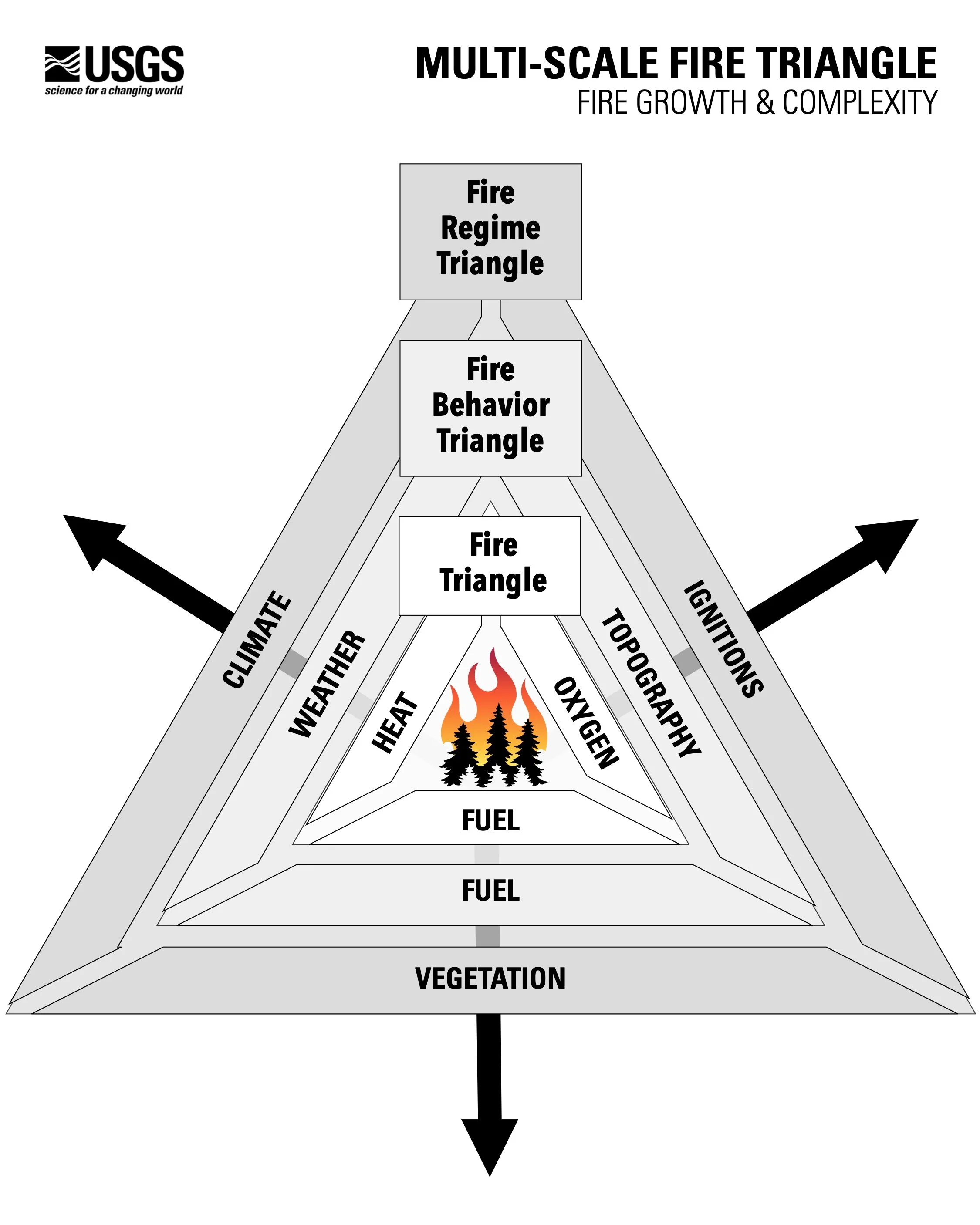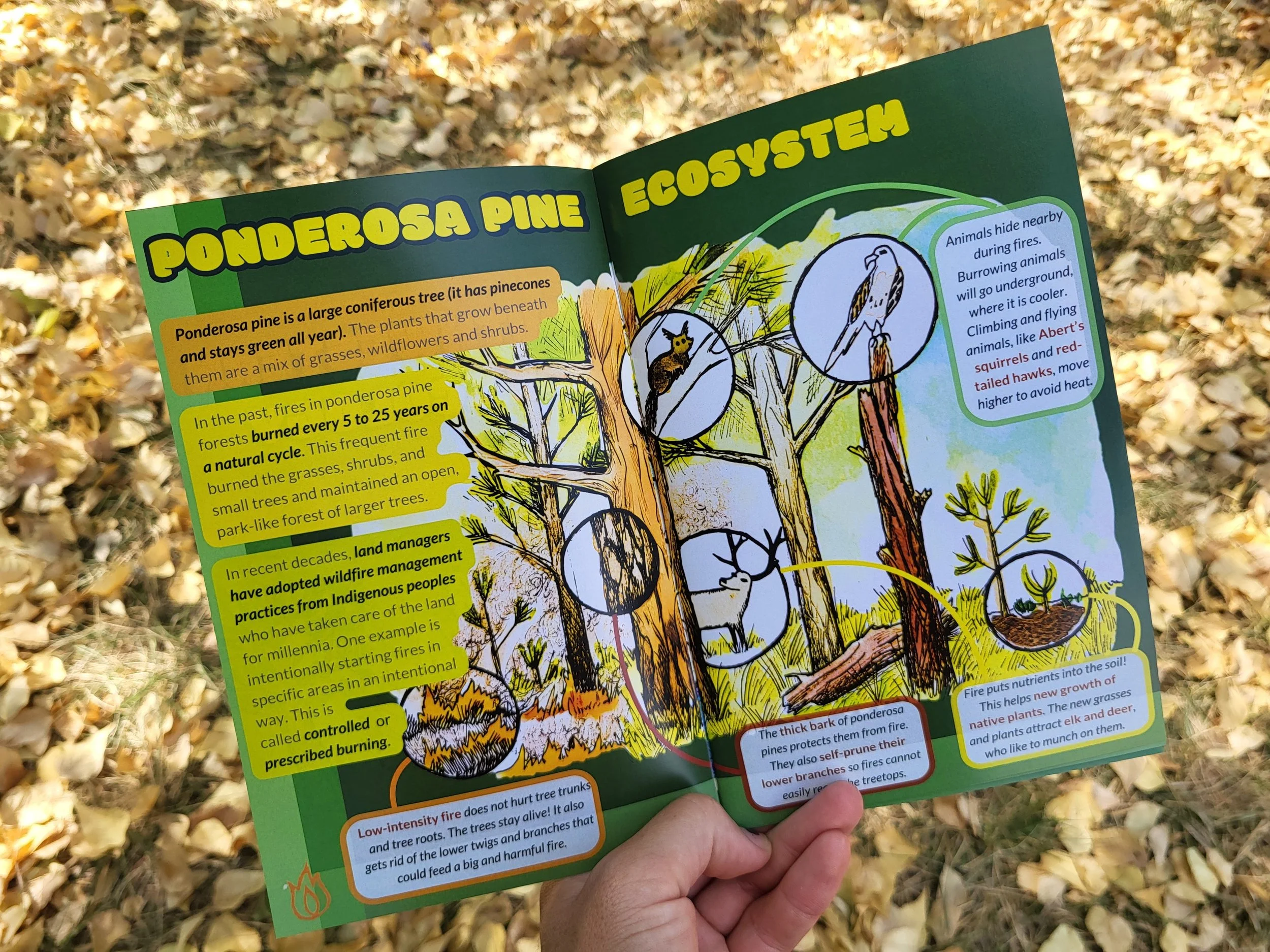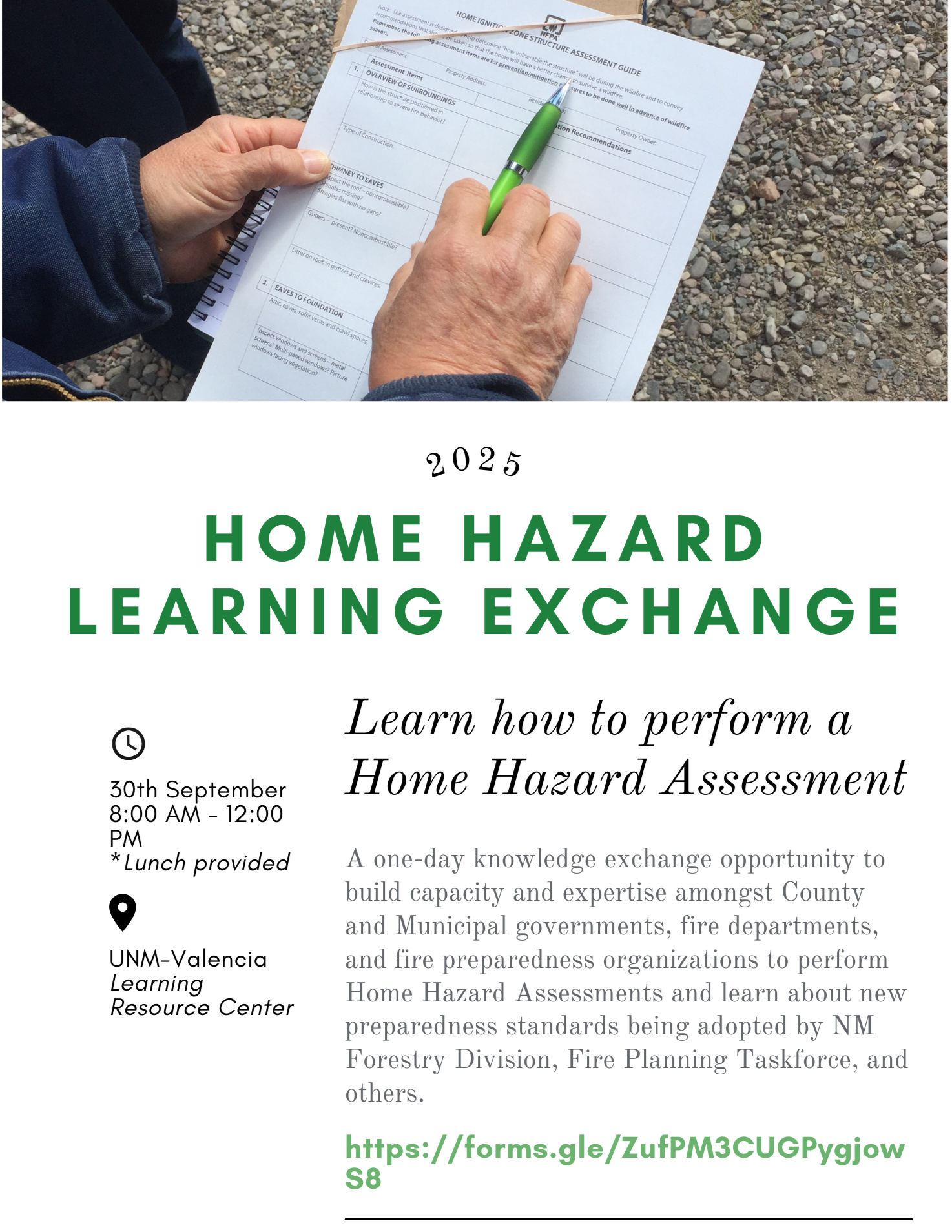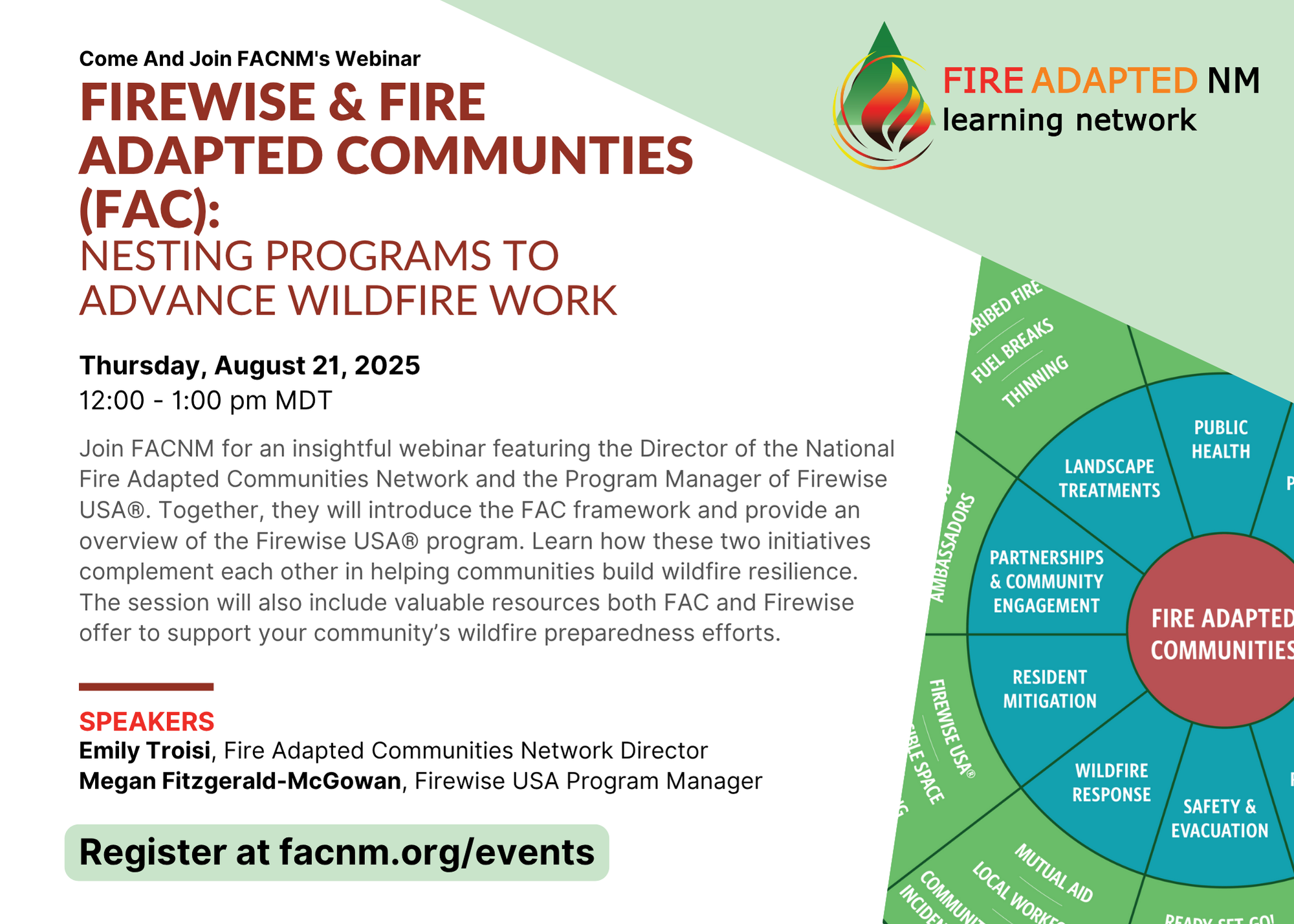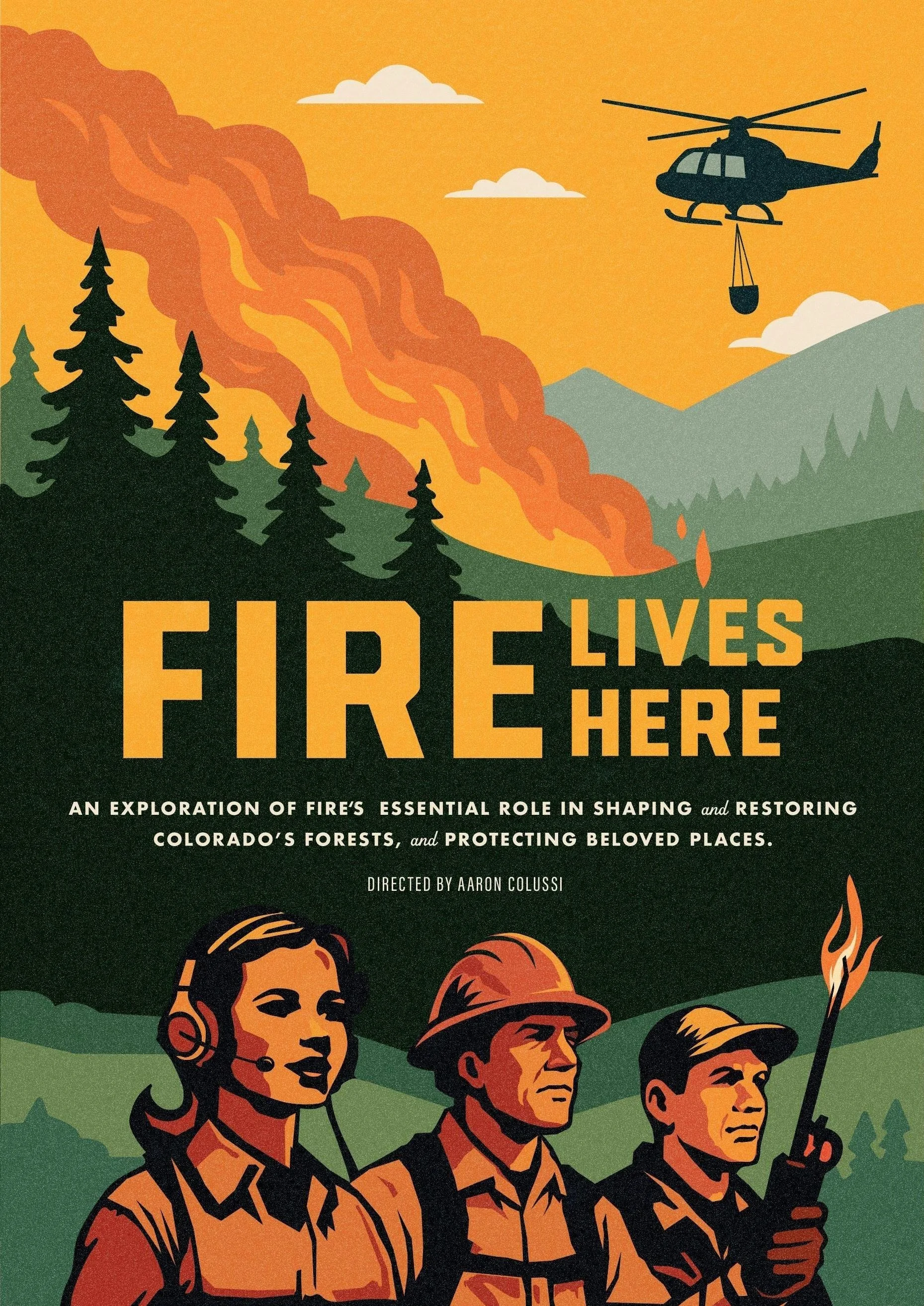Hello FAC readers,
“Fire has shaped the diverse landscapes of the Southwest for thousands of years… By understanding the natural role of fire, we can make informed decisions about restoring and maintaining resilient landscapes.” (Southwest Fire Science Consortium, Fire Regimes of the Southwest)
In New Mexico, our human communities are located in, and live in rhythm with, many different types of ecosystems which sport an array of vegetation and climates. From the high elevation mixed conifer forests to the low elevation desert grassland, this week we will be diving into how some of these ecosystems evolved with fire and how they are impacted by fire today.
This Wildfire Wednesday features:
Additional Resources and Upcoming Events
Events
2025 Wildland Urban Fire Summit (WUFS)
Home Hazard Assessment workshop
Upcoming webinars
Firewise & Fire Adapted Communities (happening 8/21!)
Fire Management Considerations in the Urban Interface
Educational primer on Community Engagement in Fire
Mini-series on fire from PBS
Take care and be well,
Megan
Fire Regimes of the Southwest
Living in the Southwest, you may have heard the term “frequent fire regime” in reference to an area or type of forest - but what does that actually mean? A fire regime describes the how fire impacts the landscape. Fire regimes are defined by the pattern, frequency, and intensity of wildfires that prevail in a specific area over long periods of time. They are highly dependent on the vegetation composition, fuel structure, climate and weather patterns, and topography of the ecosystem in which they occur. Over a very long time, the prevalent fire regime can shape the plants and animals which exist in a given area - if fires are too frequent, plants may be killed before they have matured or before they have set sufficient seed to ensure population recovery, but if fires are too infrequent, plants may mature and die without ever releasing their seed.
Fire regimes can change, even over short distances, with changes in terrain and topography, climate or weather, and fuel. Understanding a landscape’s historic fire regime is important for understanding and predicting future fire regime changes and the interactions between fire and climates. It is how we can determine whether some areas are becoming converted to historically unprecedented regimes (e.g. are fires regularly burning hotter and killing more trees than they used to?).
To help managers, practitioners, students, and community members understand the fire regime in their backyard (and elsewhere in the Region!), we are highlighting several resources for learners of all ages.
FACNM: Resources for Children and Educators
Fire Adapted New Mexico recently published a new Resources webpage with fire-related curriculums, printable booklets, toolkits, and engaging fire prevention materials that are targeted toward educators and students. The FAC Facts: Southwestern Fire Ecology booklet explores the five most common ecosystem types in New Mexico and how fire plays a role in each. In this booklet, you will find information about the plants, animals, and histories of these places where we live, work, and play.
…………………………………
SWFSC: Fire Regimes of the Southwest (Factsheets & Videos)
Over the past several years, the Southwest Fire Science Consortium worked with researchers and experts in their fields to create a series of factually accurate and informative videos and factsheets on the dominant fire regimes of five major ecotypes found in the Southwest. Each video provides information about the ecosystem it is covering, the plant associations in that ecosystem and how they react to fire, elements of the fire regime, how the regime is changing, management implications, and the science behind the video. Viewers will gain knowledge to help them understand the role of fire in each ecosystem, a crucial step to be able to develop and implement effective management to maintain landscape resilience and protect assets and values at risk from catastrophic fires. The Consortium hopes to continue expanding upon this series to include other important ecotypes such as riparian areas (e.g. the Bosque).
This video series is part of the larger World of Wildland Fire (WETC) educational video effort which aims to provide and connect fire science educators and trainers with scientifically solid and peer-reviewed teaching tools and techniques using state-of-the-art materials. This WETC’s YouTube page also contains great videos on fire behavior, fire weather, and more for additional learning.
In addition to videos, the Consortium has also produced factsheets for Ponderosa Pine and Spruce-Fir ecosystems for fire and forestry practitioners. These short guidance documents provide information about that ecosystem’s fire regime characteristics, current management, and indications for the future of that ecosystem type in hotter and drier conditions.
Additional Resources and Upcoming Events
Events
2025 New Mexico Wildland Urban Fire Summit
September 30 - October 2 // UNM - Valencia Student Community Center
Join your peers, community leaders, fire service professionals, and federal, state, tribal, and local governments this year in Valencia County for the Wildland Urban Fire Summit! WUFS is New Mexico’s leading in-person event for wildfire preparedness and planning. Community members will share regional history and discuss living in and adapting to the Wildland Urban Interface. Learn the latest techniques, strategies, and resources for wildfire preparedness, mitigation, and recovery. Expand your network of peers and experts to assist you in your fire/disaster resiliency goals.
Featured sessions include:
A panel presentation on SB33, including members of the NM Fire Planning Task Force
A presentation focused on insurance in the WUI
A panel of electrical cooperators discussing their programs and recommendations
Registration is $150 for government employees, and $50 for students, nonprofits, and the general public.
…………………………………
Home Hazard Assessment Learning Exchange
September 30, 8 AM - 12 PM // UNM - Valencia Learning Resource Center
Join FACNM and partners from across the state for a workshop before this year’s New Mexico Wildland Urban Fire Summit. This free Home Hazard Assessment workshop is focused on building capacity and expertise amongst County and Municipal governments, fire departments, and fire preparedness organizations to perform Home Hazard Assessments.
Registration is required to attend and participation will be capped at 15 attendees. Registrants who will be performing HHAs to assist their community will be prioritized for participation.
WUFS Registration is not required to participate in this workshop and no fee will be charged for this workshop.
Webinars
Firewise & Fire Adapted Communities: Nesting Programs to Advance Wildfire Work
August 21, 12:00-1:00pm
Join FACNM tomorrow for our webinar featuring the Director of the national Fire Adapted Communities Network and the Program Manager of Firewise USA®. Together, they will introduce the FAC framework and provide an overview of the Firewise USA® program. Learn how these two initiatives complement each other in helping communities build wildfire resilience. The session will also include valuable resources both FAC and Firewise offer to support your community’s wildfire preparedness efforts.
…………………………………
Fire Management Considerations in the Urban Interface
September 3, 8:30 Pacific / 9:30 Mountain / 10:30 Central (1.5 hr)
Large loss wildfires are a growing concern in much of the central and western US, where wildfires originating or moving into the wildland-urban interface continue to impact high value residential and commercial infrastructure. As such, fire managers continue to face challenges in terms of reining in suppression costs and allocation of resources on large urban-interface fires, as well as mitigating millions of acres of hazardous fuels at a meaningful pace and scale.
Dave Calkin and Michael Tiller will be the presenters in this webinar in the Prescribed Fire for Forest Management series from the University of Wisconsin.
Educational Resource (for community wildfire practitioners)
Community Engagement in Fire Preparedness: It’s How that Matters
This primer is for any community wildfire practitioner who wants to further develop their skills and tools for engaging people in their place. It focuses on wildfire preparedness with adult community members at local levels, although it is relevant to multiple contexts. It highlights selected concepts and practices that may help you overcome challenges, deepen relationships, support shared learning and even make the work more fun and meaningful.
From the authors: “After reading this primer, we hope that you will see the differences between traditional and more engagement-focused approaches, and undertake engagement that serves whole communities, uses the science of how adults learn and incorporates trauma-informed practices.”
Key content includes:
Understanding and working with whole communities
Relational engagement: Creating long-term partnerships
Delivering wildfire education programs with impact
Trauma-informed approach
View the full primer here: https://extension.oregonstate.edu/catalog/em-9467-community-engagement-fire-preparedness-its-how-matters
Film
Fire Lives Here // Public Broadcasting Corporation (Free)
Through the voices of scientists, firefighters, and forest stewards, this documentary reveals how fire shapes the land, restores our forests, and holds the key to protecting the places we love.
Created by the Northern Colorado Fireshed Collaborative, in partnership with the National Forest Foundation and Arapaho and Roosevelt National Forests, “Fire Lives Here” showcases the year-round efforts of the Northern Colorado Fireshed to work together to change wildfire outcomes in Colorado.
